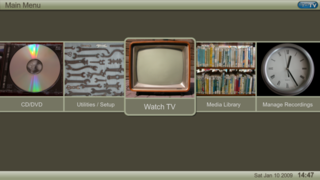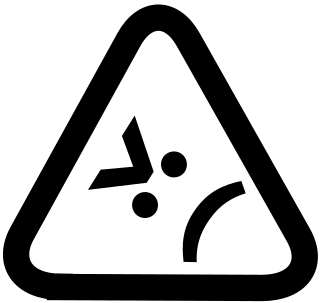Related Research Articles
Pretty Good Privacy (PGP) is an encryption program that provides cryptographic privacy and authentication for data communication. PGP is used for signing, encrypting, and decrypting texts, e-mails, files, directories, and whole disk partitions and to increase the security of e-mail communications. Phil Zimmermann developed PGP in 1991.
Trusted Computing (TC) is a technology developed and promoted by the Trusted Computing Group. The term is taken from the field of trusted systems and has a specialized meaning that is distinct from the field of confidential computing. With Trusted Computing, the computer will consistently behave in expected ways, and those behaviors will be enforced by computer hardware and software. Enforcing this behavior is achieved by loading the hardware with a unique encryption key that is inaccessible to the rest of the system and the owner.

The Next-Generation Secure Computing Base is a software architecture designed by Microsoft which claimed to provide users of the Windows operating system with better privacy, security, and system integrity. NGSCB was the result of years of research and development within Microsoft to create a secure computing solution that equaled the security of closed platforms such as set-top boxes while simultaneously preserving the backward compatibility, flexibility, and openness of the Windows operating system. Microsoft's primary stated objective with NGSCB was to "protect software from software."

Novell, Inc. was an American software and services company headquartered in Provo, Utah, that existed from 1980 until 2014. Its most significant product was the multi-platform network operating system known as Novell NetWare.
A key generator (key-gen) is a computer program that generates a product licensing key, such as a serial number, necessary to activate for use of a software application. Keygens may be legitimately distributed by software manufacturers for licensing software in commercial environments where software has been licensed in bulk for an entire site or enterprise, or they may be developed and distributed illegitimately in circumstances of copyright infringement or software piracy.
Copy protection, also known as content protection, copy prevention and copy restriction, describes measures to enforce copyright by preventing the reproduction of software, films, music, and other media.
FairPlay is a family of digital rights management (DRM) technologies developed by Apple Inc. for protecting videos, books and apps and historically for music.

A software protection dongle is an electronic copy protection and content protection device. When connected to a computer or other electronics, they unlock software functionality or decode content. The hardware key is programmed with a product key or other cryptographic protection mechanism and functions via an electrical connector to an external bus of the computer or appliance.
Commercial software, or seldom payware, is a computer software that is produced for sale or that serves commercial purposes. Commercial software can be proprietary software or free and open-source software.

MythTV is a free and open-source home entertainment application with a simplified "10-foot user interface" design for the living room TV. It turns a computer with the necessary hardware into a network streaming digital video recorder, a digital multimedia home entertainment system, or home theater personal computer. It can be considered a free and open-source alternative to TiVo or Windows Media Center. It runs on various operating systems, primarily Linux, macOS, and FreeBSD.
Windows Media DRM or WMDRM, is a Digital Rights Management service for the Windows Media platform. It is designed to provide delivery of audio or video content over an IP network to a PC or other playback device in such a way that the distributor can control how that content is used.
Digital distribution, also referred to as content delivery, online distribution, or electronic software distribution, among others, is the delivery or distribution of digital media content such as audio, video, e-books, video games, and other software.
Intertrust Technologies Corporation is a software technology company specializing in trusted distributed computing. Intertrust’s product lines consist of a DataOps platform, Application protection and Content protection solutions. Much of Intertrust's digital rights management (DRM) business is based on the Marlin DRM technology, which Intertrust founded along with four consumer electronics companies: Sony, Panasonic, Philips, and Samsung.
The open music model is an economic and technological framework for the recording industry based on research conducted at the Massachusetts Institute of Technology. It predicts that the playback of prerecorded music will be regarded as a service rather than as individually sold products, and that the only system for the digital distribution of music that will be viable against piracy is a subscription-based system supporting file sharing and free of digital rights management. The research also indicated that US$9 per month for unlimited use would be the market clearing price at that time, but recommended $5 per month as the long-term optimal price.

Defective by Design (DBD) is a grassroots anti-digital rights management (DRM) initiative by the Free Software Foundation (FSF) and CivicActions. Launched in 2006, DBD believes that DRM makes technology deliberately defective, negatively affects digital freedoms, and is "a threat to innovation in media, the privacy of readers, and freedom for computer users." The initiative regularly campaigns against the use of DRM by the media industry and software industry to increase awareness of the anti-DRM movement and pressure industries into no longer using DRM. They are known for their use of hazmat suits in their demonstrations.
This is a comparison of digital video recorder (DVR), also known as personal video recorder (PVR), software packages. Note: this is may be considered a comparison of DVB software, not all listed packages have recording capabilities.
Information rights management (IRM) is a subset of digital rights management (DRM), technologies that protect sensitive information from unauthorized access. It is sometimes referred to as E-DRM or Enterprise Digital Rights Management. This can cause confusion, because digital rights management (DRM) technologies are typically associated with business-to-consumer systems designed to protect rich media such as music and video. IRM is a technology which allows for information to be ‘remote controlled’.
Proprietary software is software that grants its creator, publisher, or other rightsholder or rightsholder partner a legal monopoly by modern copyright and intellectual property law to exclude the recipient from freely sharing the software or modifying it, and—in some cases, as is the case with some patent-encumbered and EULA-bound software—from making use of the software on their own, thereby restricting their freedoms.
Digital rights management (DRM) is the management of legal access to digital content. Various tools or technological protection measures (TPM) like access control technologies, can restrict the use of proprietary hardware and copyrighted works. DRM technologies govern the use, modification and distribution of copyrighted works and of systems that enforce these policies within devices. DRM technologies include licensing agreements and encryption.
Didiom was a digital media company that specialized in the development of streaming media applications and wireless content delivery platforms. Built on peer-to-peer placeshifting technology, the company's flagship product allowed customers to stream their home computer's audio collection to their phone wirelessly, eliminating the need for data cables and memory cards. With two million songs under its management, Didiom previously launched an on-device music store that allowed customers to name their own prices for music downloads. In February 2011, Didiom was acquired by SnapOne, Inc.
References
- ↑ Ryoichi Mori, Masaji Kawahara, "Superdistribution: The Concept and the Architecture". Transactions of The Institute of Electronics, Information, and Communication Engineers, vol. E73 #7, July 1990, pp.1133–1146.
- ↑ Ryoichi Mori, Masaji Kawahara, "Superdistribution: An Electronic Infrastructure for the Economy of the Future". Transactions of the Information Processing Society of Japan, vol. 38 #7 July 1997, pp. 1465–1472.
- ↑ Ryoichi Mori : "What Lies Ahead", BYTE, Vol.14. No.1, pp.346-348 (1989),
- ↑ Ryoichi Mori, "On Software Service --Several steps for the micro electronics revolution" (in Japanese), Journals of Japan Electronic Computer Co. Ltd., #3 October 1983, pp.16-26.
- ↑ Ryoichi Mori, "Software Service Systems" (in Japanese),Journal of The Institute of Electronics and Communication Engineers, vol.67 #4, April 1984, pp.431-436.
- ↑ Patent application Showa 58-186100 (in Japanese), Software Management System, Japan Patent Office, October 5, 1983, Ryoichi Mori, applicant. (The usual English translation of the application lists Forest Akikazu as the applicant, but that is a mistranslation of Mori's name.)
- ↑ U.S. Patent 5,103,392, System for storing history of use of programs including user credit data and having access by the proprietor, Inventor: Mori, Ryoichi (Tokyo, JP), April 7, 1992 (filed December 5, 1990).